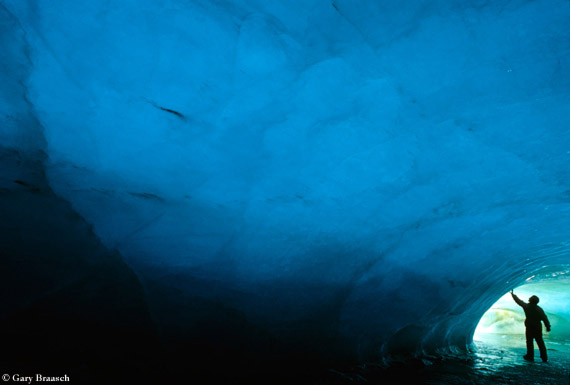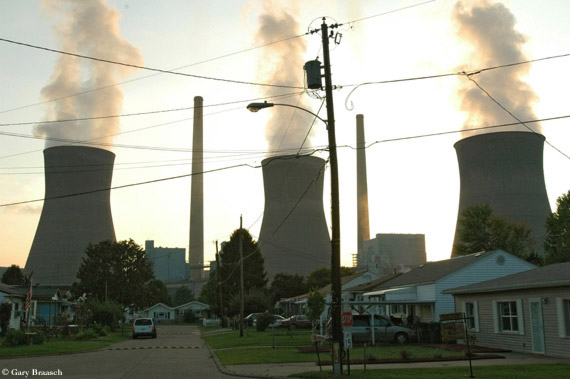Gary Braasch’s Images of Change: Documenting a Warming World
My work as a professional journalist and environmental photographer led me to climate change 11 years ago when I found my first independent funding source – a small environmental foundation – and established World View of Global Warming. This science-based photojournalistic documentation project is about global warming and its broader implications around the world. It is a witness, in words and pictures, to the scientific evidence of Earth’s significant changes affecting people and landscapes, as well as a chronicle of solutions undertaken.
The project goals are to educate, to inspire and to influence the public, policy makers and young people about the science of climate change and its full meaning. Throughout the work, my objectives were to report what scientists were seeing and to document locations they found, which were already changing under global warming’s influence. As a result, I immediately discovered many people living at risk from climate change impacts. Their images also became important in the work. In addition, technological and community solutions to ever increasing carbon emissions became a project feature because we must be able to visualize our future.
Following climate change to 25 countries on all continents, I have photographed and documented climate subjects from beyond the Arctic and Antarctic Circles to beneath sea level to above 15,000 ft. in the Andes. The resulting photos have been widely viewed in exhibits at Chicago’s Field Museum, the Minnesota Science Museum, in a display for the 40th Anniversary of the U.S. Environmental Protection Agency, as well as two exhibits at the American Association for the Advancement of Science in Washington, D.C. In addition, the United Nations has published my images as calendars and international postage stamps. Perhaps more importantly, thousands of teachers and professors have used these photographs from the project website, www.worldviewofglobalwarming.org, and my two published books.
The images are excellent learning tools and models of communication as they draw people into the subject matter and graphically show locations of climate change effects. People in Miami, for example, can now understand they are in the same situation as people in Bangladesh, the Netherlands, Alaska and Tuvalu with respect to being displaced by sea level rise.
Pictures are not science. However, they can provide direct evidence that global warming is happening now all over the world. It is clear to me that I am documenting a decisive, overarching event of the 21st Century – one with no equal in the previous centuries of human civilization. This is truly a global change. Fortunately, we can do a great deal to counteract these effects and many of us have already begun.
The Challenges of Climate Change
The first challenge is to realize the scientific message: We are changing the climate and more rapidly than at any other time in Earth’s history. This is a powerful truth considering climate’s controlling role in habitat creation for every living thing in addition to its influence over the course of human events.
Right now, polar and mountain landscapes are under fire from warming climate regimes. Retreating ice exposes more land; permafrost thaws; land rises and slides. Entire ecosystems are reacting. North polar cultures face dislocation and identity loss while an open Arctic Ocean shifts geopolitics. Inhabitants of alpine regions will have to adapt tradition, agriculture, infrastructure and recreation. Glacier-fed rivers will change, as will all who live in these watersheds. The Earth is becoming a different planet.
The 400,000 Alaskan Natives living in the north are experiencing the thaw in all facets of their lives. As documented in the Arctic Climate Impact Assessment, even though their ancestors lived in these locations at least 20,000 years ago and, over time, withstood many climate changes, the current warming is so rapid that it is straining human resilience. The very ground and waters these people live on and hunt over no longer conform to their ancient knowledge of seasons and weather. Inuit leader Sheila Watt-Cloutier of Nunavut, Canada, testified before the U.S. Congress that climate change “is a matter of livelihood, food and individual and cultural survival. It is a human issue. The Arctic is not a wilderness or a frontier. It is our home and homeland.”

Gary Braasch|Hatteras, North Carolina, house
Climate change also affects landscapes, which many people around the world treasure and need for support. The list of famed parks and World Heritage Sites under great pressure from climate change reads like an ecotourist’s dream itinerary: the Everglades, West Bengal’s Sundarban mangrove forest, the Great Barrier Reef, the Florida Keys, Monteverde Cloud Forest, the Daintree rainforest of northern Queensland, Glacier National Park, Mt. Kilimanjaro, Nepal’s Sagarmatha National Park, the Farallon Islands, Alaska’s Arctic National Wildlife Refuge and the Antarctic Peninsula, to name just a few. Connecting climate changes to local places of value and protection can make the science real.
Protected lands in national parks and reserves, and managed lands like pastures and forests, may deteriorate as climate shifts. Climate change can make overpopulation pressures and land abuse worse. We need to protect biodiversity and whole ecosystems not just for their sake alone, but also to ensure continuation of their support services like fresh water, soil creation, food and materials. We need strong natural systems to help us survive climate change.
However they materialize, new controls on greenhouse gas emissions will have to be made across the entire spectrum of energy production and use. Heroes of our new world will emerge based on their contribution to keeping Earth from becoming too hot. They will ignore international policy regarding which nation is “developed” and which is “developing” and look only at greenhouse emissions. They will realize every nation is at risk, no matter its wealth or power. Leaders will be willing to state and to accept the tremendous difficulty incumbent in the transformation away from polluting fossil fuels. But, they also will inform their constituents and peers about the benefits, including gains in health and well being, which will accrue for everyone as the world becomes more efficient and renewably powered.
This is Climate Change

Gary Braasch
A new public education initiative on today’s ongoing climate change using my images is now in place at Reagan National Airport in Washington, D.C. As a result, many of the airport’s 50,000 daily passengers will see a different kind of advertisement in the concourse in the form of a photographic billboard. This Is Climate Change, a Del Mar Global Trust educational project, unveiled its first in a series of large backlit photographs featuring my time series view of Alaska’s shrinking Mendenhall Glacier. As part of World View of Global Warming, in 2008 I rephotographed an 1894 image to show the visible effect of global warming on the glacier near Juneau. In addition to Reagan National, This Is Climate Change project will place photographs and other strong visuals in other public locations to show how climate change is real and currently impacting the United States.
Despite overwhelming scientific findings substantiating climate change, a 2010 Pew Research Center poll found that only 59 percent of Americans believed there was solid evidence Earth was getting warmer. According to This is Climate Change Project Director Elena Marszalek, the numerous scientific reports and publications affirming that climate change is real and human-induced have not seemed to sway public opinion. Therefore, our organization thought an approach focusing on changes already affecting the U.S. would make climate change a more relevant issue to the American public.
The Del Mar Global Trust chose to collaborate with me because of my celebrated series of views of climate change affected landscapes. The backlit photographic billboard will be in Reagan National Airport for one year. The project is planning other displays of global warming in other public locations, as well as further collaborations. For more information please go to http://www.ThisIsClimateChange.org.
Gary Braasch’s Warming World Slideshow






















































